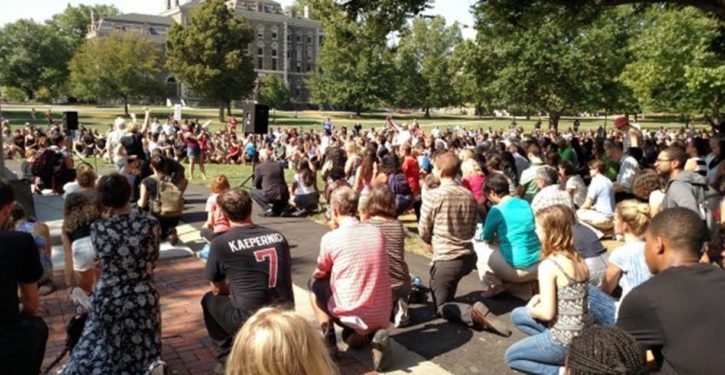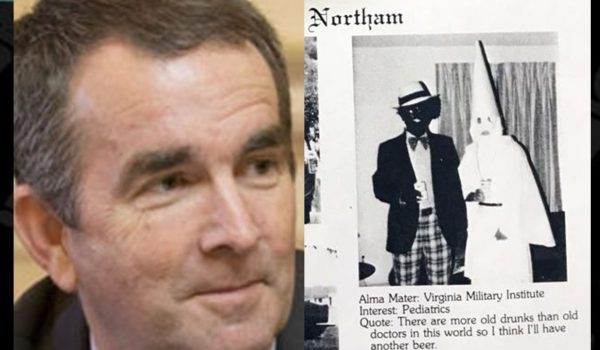
A faculty coalition at Cornell University is calling for race-based hiring and promotions. What it is demanding violates two laws against racial discrimination, Title VII of the Civil Rights Act and 42 U.S.C. 1981. That’s because Cornell has no justifiable rationale for using race in employment decisions at all, much less to the extent that the faculty coalition demands.
For example, the Cornell Faculty Coalition demands that the University “abolish colorblind recruitment policies and practices in partner/spousal hiring” and “make retention offers for all BIPOC faculty” — that is, offer raises to all faculty who are black, indigenous, or people of color, to match offers they receive from other colleges. It also calls for “Departments to make cluster hires of Black and other faculty of color” and recruit “graduate students of color in clusters and cohorts in departments.”
But employers usually cannot discriminate based on race — even against white people. The Supreme Court ruled that firing white employees based on their race violated two federal laws, Title VII and 42 U.S.C. 1981, in its decision in McDonald v. Santa Fe Trail Transportation Co. (1976).
Will this presidential election be the most important in American history?
There are exceptions where employers are allowed to use race under Title VII, but none that apply to Cornell. Companies can give minorities a racial preference to fix what the Supreme Court calls a “manifest racial imbalance” in “traditionally segregated job categories.” (See United Steelworkers v. Weber (1979)).
But Cornell University does not have a history of such segregation, and it does not have a “manifest racial imbalance,” either. It is true that its faculty is 81% white, but it long has had black and Hispanic faculty. Cornell is nearly as diverse as Tompkins County, in which it is located, and more diverse than other nearby counties, which are 88-96% white. Tompkins County is 81% white (77% non-Hispanic white).
Nor are Cornell’s faculty demographics out of line with America as a whole. Nationally, 76% of college faculty are white, according to the National Center for Education Statistics. Cornell’s fellow Ivy League school Dartmouth College has a faculty that is 88.8% white, according to College Factual.
It’s true that America as a whole is more heavily non-white than Cornell. For example, blacks alone are 13% of America’s population.
But that doesn’t mean Cornell has a “racial imbalance” in the legal sense, much less a “manifest” one. Whether a racial imbalance exists is legally determined by comparing the demographics of Cornell’s workforce to the “relevant qualified area labor pool,” which only includes those people “actually qualified for the position.” (See Janowiak v. South Bend (1984)).
So if there aren’t many blacks with doctorates and other Ivy League credentials, then the small number of blacks at an Ivy League school like Cornell is not considered a “racial imbalance.” As the Supreme Court has explained, “the comparison should be with those in the labor force who possess the relevant qualifications.” (See Johnson v. Transportation Agency (1987)).
In more than a dozen academic fields, “not a single black student earned a doctoral degree in 2017,” notes The Atlantic. Cornell students disproportionately major in fields where there are relatively few black Ph.Ds and professors, such as engineering, agriculture, and computer science. Blacks made up only 4% of PhDs in engineering and computer science in 2016. They made up zero percent of all PhDs in agricultural economics.
For skilled positions like college faculty, it is not enough to show that blacks are underrepresented compared to “general population statistics.” (See Janowiak v. South Bend (1984)).
Cornell’s rural location far from black population centers would also be expected to reduce the number of blacks working there, leaving it with fewer minority faculty than some other Ivy League institutions (especially those that have long aggressively practiced affirmative action). For unskilled positions, the qualified labor pool at Cornell would be its general region, including not just 81% white Tompkins County, but also even more heavily-white Cortland County, which is 92.7% white. (See Hammon v. Barry (1987)).
Moreover, before an institution can give minorities a racial preference, there must be not just a “racial imbalance” but a “manifest” and “conspicuous” one. For example, the Supreme Court found a manifest racial imbalance where “only 1.83% (5 out of 273) of the skilled craftworkers at” a steel plant “were black, even though the work force in the Gramercy area was approximately 39% black.” (United Steelworkers v. Weber (1979)).
Cornell, by contrast, has minority representation equal or greater than that of many other universities. While its faculty is less non-white than the average college’s faculty, that is to be expected, given its location and the academic fields it focuses on.
In addition to the fact that Cornell has no “manifest racial imbalance” that would justify using race in hiring or promotions, its faculty positions are not “traditionally segregated job categories” for which racial preferences would be appropriate. Cornell and the Ivy League have long employed minority faculty and practiced affirmative action to recruit students and faculty. (See, e.g., Regents of the University of California v. Bakke (1978) (discussing the “Harvard plan” of race-conscious admissions to enroll more minority students)).
“Traditionally segregated job categories” are jobs from which minorities or women have been systematically excluded in the relatively recent past. In its Weber decision, the Supreme Court treated craftworkers as a steel plant as a “traditionally segregated” job, “because blacks had long been excluded from craft unions,” including in the prior decade. That was shown by recent “judicial findings of exclusion from crafts on racial grounds” that were “so numerous as to make such exclusion a proper subject for judicial notice.” Similarly, in its Johnson decision, the Supreme Court cited the fact that “women had not traditionally been employed in [the] positions” for which affirmative action was being used. In light of the “limited opportunities that have existed in the past” for women in those “job classifications,” those jobs were “traditionally segregated.”
By contrast, minorities have been employed, and had the opportunity to be employed, in college faculties for generations, especially at Cornell. Colleges have not excluded or systematically discriminated against minorities in a long time, especially not Cornell. It is well-known that Ivy League universities like Cornell practice affirmative action, as the Supreme Court noted in discussing Harvard’s practice of giving minority applicants a preference in admissions. (See Regents of the University of California v. Bakke (1978)).
Far from being segregated, Cornell has enrolled minority students since the mid-1880s. In 1969, Cornell established its Africana Studies and Research Center, one of the first such black studies programs in the Ivy League, staffed by black scholars.
Cornell also cannot use race in faculty hiring or promotions in the name of “diversity.” Title VII’s ban on racial discrimination does not contain a “diversity” exception. An appeals court ruled it violated the Title VII for a school to consider employees’ race in employment decisions in order to achieve “diversity.” (See Taxman v. Board of Education (1996)). While considering race as one of many factors in admissions to promote diversity does not violate the Constitution, it does violate Title VII to make employment decisions based on race, even in the educational setting.
For all these reasons, for Cornell to use race in faculty hiring or promotions would violate Title VII of the Civil Rights Act.
It also would violate another federal law, 42 U.S.C. 1981, which bans racial discrimination in contracts. The Supreme Court has interpreted that law, which covers private and public institutions alike, as banning the same racial preferences that the Constitution forbids at state institutions. The Supreme Court ruled that the University of Michigan violated this law by using a point system in admissions that gave blacks and Hispanics 20 extra points. That violated both the Constitution and 42 U.S.C. 1981. (See Gratz v. Bollinger, 539 U.S. 244, 276 n.23 (2003)).
Under the Constitution, diversity is not a valid reason for using race in employment, as opposed to college admissions. (See Lutheran Church — Missouri Synod v. FCC (1998)).
Nor does Cornell have any other valid reason to use race in hiring or promotions.
Remedying past discrimination by an institution can be a valid reason for it to use race in employment under the Constitution and 42 U.S.C. 1981. (See Richmond v. J.A. Croson Co. (1989)).
But only when there is a prima facie case of recent, widespread discrimination by the institution that has left present effects. There is no sign of such discrimination at Cornell, much less widespread discrimination.
To give minorities a racial preference, an institution must point to evidence that it committed a “systemic pattern of discrimination” against them, not just cite “individual claims of discrimination” by people of color. (See Coral Construction Co. v. King County (1991)).
That means discrimination by the institution itself, not “societal discrimination.” (See Richmond v. J.A. Croson Co. (1989)).
Thus, “the horrific murder of George Floyd” cited by the Cornell Faculty Coalition is not a valid reason for Cornell to use race, even assuming that Mr. Floyd was killed because of his race.
Moreover, discrimination against minorities has to be recent, say in the last 20 years, before it justifies a racial preference. (See, e.g., Hammon v. Barry (1987); Brunet v. City of Columbus (1993)).
Many courts also say that the discrimination has to have been “intentional” before it can justify the use of race as a remedy for it. (See, e.g., Michigan Road Builders v. Milliken, 834 F.2d 583, 593 (6th Cir. 1987), aff’d, 489 U.S. 1061 (1989); Builders Association v. County of Cook, 256 F.3d 642, 644 (7th Cir. 2001); People Who Care v. Rockford Board of Education, 111 F.3d 528, 534 (7th Cir. 1997)).
Cornell cannot show any of these things, so it has no legally valid reason to consider race in hiring or promotions under 42 U.S.C. 1981.




